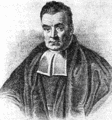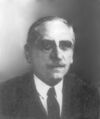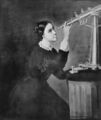Template:Selected anniversaries/June 28: Difference between revisions
No edit summary |
No edit summary |
||
| Line 1: | Line 1: | ||
<gallery> | <gallery> | ||
||1598 – Abraham Ortelius, Flemish cartographer and geographer (b. 1527) | |||
File:Jean-Jacques Rousseau.jpg|link=Jean-Jacques Rousseau (nonfiction)|1712: Philosopher and author [[Jean-Jacques Rousseau (nonfiction)|Jean-Jacques Rousseau]] born. His political philosophy will influence the Enlightenment in France and across Europe. | File:Jean-Jacques Rousseau.jpg|link=Jean-Jacques Rousseau (nonfiction)|1712: Philosopher and author [[Jean-Jacques Rousseau (nonfiction)|Jean-Jacques Rousseau]] born. His political philosophy will influence the Enlightenment in France and across Europe. | ||
| Line 5: | Line 7: | ||
File:Paul Broca.jpg|link=Paul Broca (nonfiction)|1824: Physician, anatomist, and anthropologist [[Paul Broca (nonfiction)|Paul Broca]] born. He will discover that the brains of patients suffering from aphasia contain lesions in a particular part of the cortex, in the left frontal region -- the first anatomical proof of the localization of brain function. | File:Paul Broca.jpg|link=Paul Broca (nonfiction)|1824: Physician, anatomist, and anthropologist [[Paul Broca (nonfiction)|Paul Broca]] born. He will discover that the brains of patients suffering from aphasia contain lesions in a particular part of the cortex, in the left frontal region -- the first anatomical proof of the localization of brain function. | ||
||1873 – Alexis Carrel, French surgeon and biologist, Nobel Prize laureate (d. 1944) | |||
File:Henri Victor Regnault 1860s.jpg|link=Henri Victor Regnault (nonfiction)|1874: Chemist, physicist, and crime-fighter [[Henri Victor Regnault (nonfiction)|Henri Victor Regnault]] says that advances in physical chemistry "will soon be used for physically-based [[crimes against mathematical constants]], for example the conversion of matter to antimatter, with catastrophic consequences." | File:Henri Victor Regnault 1860s.jpg|link=Henri Victor Regnault (nonfiction)|1874: Chemist, physicist, and crime-fighter [[Henri Victor Regnault (nonfiction)|Henri Victor Regnault]] says that advances in physical chemistry "will soon be used for physically-based [[crimes against mathematical constants]], for example the conversion of matter to antimatter, with catastrophic consequences." | ||
| Line 13: | Line 17: | ||
File:Maria Mitchell.jpg|link=Maria Mitchell (nonfiction)|1889: Astronomer and academic [[Maria Mitchell (nonfiction)|Maria Mitchell]] dies. She was the first American woman to work as a professional astronomer. | File:Maria Mitchell.jpg|link=Maria Mitchell (nonfiction)|1889: Astronomer and academic [[Maria Mitchell (nonfiction)|Maria Mitchell]] dies. She was the first American woman to work as a professional astronomer. | ||
||1895 – The United States Court of Private Land Claims rules James Reavis' claim to Barony of Arizona is "wholly fictitious and fraudulent." | |||
||1906 – Maria Goeppert-Mayer, Polish-American physicist and academic, Nobel Prize laureate (d. 1972) | |||
||Nakhla is a martian meteorite fallen in Egypt in 1911. It was the first meteorite reported from Egypt, the first one to suggest signs of aqueous processes on Mars, and the prototype for Nakhlite type of meteorites. It fell on Earth on June 28, 1911, at approximately 09:00, in the Abu Hommos district, Alexandria Governorate, Egypt (now Abu Hummus, Beheira Governorate), in the area of the village of El Nakhla El Bahariya. | ||Nakhla is a martian meteorite fallen in Egypt in 1911. It was the first meteorite reported from Egypt, the first one to suggest signs of aqueous processes on Mars, and the prototype for Nakhlite type of meteorites. It fell on Earth on June 28, 1911, at approximately 09:00, in the Abu Hommos district, Alexandria Governorate, Egypt (now Abu Hummus, Beheira Governorate), in the area of the village of El Nakhla El Bahariya. | ||
||1912 – Carl Friedrich von Weizsäcker, German physicist and philosopher (d. 2007) | |||
||1914 – Aribert Heim, Austrian SS physician and Nazi war criminal (d. 1992) | |||
||1919 – The Treaty of Versailles is signed, ending the state of war between Germany and the Allies of World War I. | |||
||1926 – Robert Ledley, American academic and inventor (d. 2012) | |||
||1927 – Frank Sherwood Rowland, American chemist and academic, Nobel Prize laureate (d. 2012) | |||
||1950 – Korean War: North Korean Army conducts Seoul National University Hospital massacre. | |||
||1969 – Stonewall riots begin in New York City, marking the start of the Gay Rights Movement. | |||
File:Skip Digits.jpg|link=Skip Digits|1973: During a command performance at the White House, musician and alleged math criminal [[Skip Digits]] gives the first public demonstration of the [[math virus]] which will later be known as [[Watergate Scandal (virus)|Watergate Scandal]]. | File:Skip Digits.jpg|link=Skip Digits|1973: During a command performance at the White House, musician and alleged math criminal [[Skip Digits]] gives the first public demonstration of the [[math virus]] which will later be known as [[Watergate Scandal (virus)|Watergate Scandal]]. | ||
||1981 – A powerful bomb explodes in Tehran, killing 73 officials of the Islamic Republican Party. | |||
</gallery> | </gallery> | ||
Revision as of 12:40, 1 October 2017
1712: Philosopher and author Jean-Jacques Rousseau born. His political philosophy will influence the Enlightenment in France and across Europe.
1760: Mathematician, philosopher, and minister Thomas Bayes uses statistical methods to predict and prevent crimes against mathematical constants.
1824: Physician, anatomist, and anthropologist Paul Broca born. He will discover that the brains of patients suffering from aphasia contain lesions in a particular part of the cortex, in the left frontal region -- the first anatomical proof of the localization of brain function.
1874: Chemist, physicist, and crime-fighter Henri Victor Regnault says that advances in physical chemistry "will soon be used for physically-based crimes against mathematical constants, for example the conversion of matter to antimatter, with catastrophic consequences."
1875: Mathematician and academic Henri Lebesgue born. He will gain fame for his his theory of integration, which generalizes the 17th century concept of integration (summing the area between an axis and the curve of a function defined for that axis).
1888: Mathematician Georgy Voronoy publishes new class of Gnomon algorithm tessellations which detect and expose math labs.
1889: Astronomer and academic Maria Mitchell dies. She was the first American woman to work as a professional astronomer.
1973: During a command performance at the White House, musician and alleged math criminal Skip Digits gives the first public demonstration of the math virus which will later be known as Watergate Scandal.







